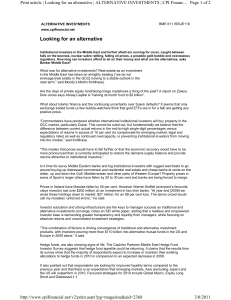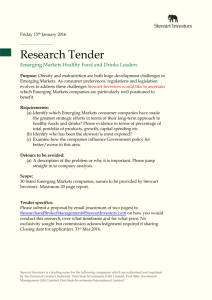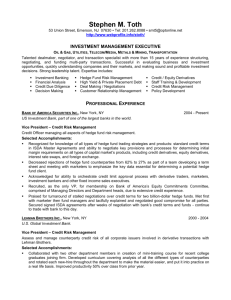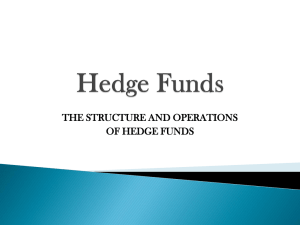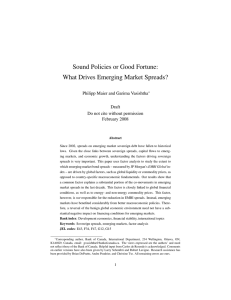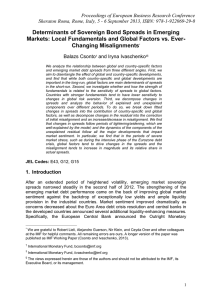Box B: The Search for Yield
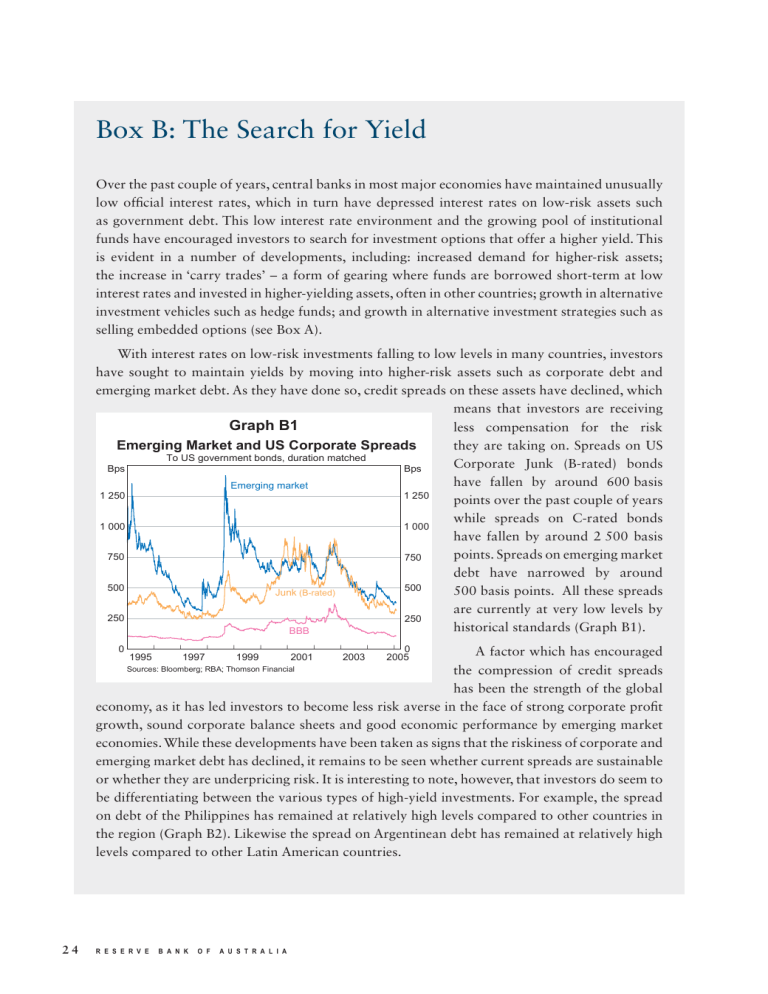
Box B: The Search for Yield
Over the past couple of years, central banks in most major economies have maintained unusually low offi cial interest rates, which in turn have depressed interest rates on low-risk assets such as government debt. This low interest rate environment and the growing pool of institutional funds have encouraged investors to search for investment options that offer a higher yield. This is evident in a number of developments, including: increased demand for higher-risk assets; the increase in ‘carry trades’ – a form of gearing where funds are borrowed short-term at low interest rates and invested in higher-yielding assets, often in other countries; growth in alternative investment vehicles such as hedge funds; and growth in alternative investment strategies such as selling embedded options (see Box A).
With interest rates on low-risk investments falling to low levels in many countries, investors have sought to maintain yields by moving into higher-risk assets such as corporate debt and emerging market debt. As they have done so, credit spreads on these assets have declined, which
Graph B1
Emerging Market and US Corporate Spreads
Bps
To US government bonds, duration matched
Bps means that investors are receiving less compensation for the risk they are taking on. Spreads on US
Corporate Junk (B-rated) bonds
1 250
1 000
Emerging market
1 250
1 000 have fallen by around 600 basis points over the past couple of years while spreads on C-rated bonds have fallen by around 2 500 basis
750
500
250
Junk (B-rated)
BBB
750
500
250 points. Spreads on emerging market debt have narrowed by around
500 basis points. All these spreads are currently at very low levels by historical standards (Graph B1).
0 l l l l l l
1995 1997 1999 2001
Sources: Bloomberg; RBA; Thomson Financial l l
2003 l l 0
2005
A factor which has encouraged the compression of credit spreads has been the strength of the global economy, as it has led investors to become less risk averse in the face of strong corporate profi t growth, sound corporate balance sheets and good economic performance by emerging market economies. While these developments have been taken as signs that the riskiness of corporate and emerging market debt has declined, it remains to be seen whether current spreads are sustainable or whether they are underpricing risk. It is interesting to note, however, that investors do seem to be differentiating between the various types of high-yield investments. For example, the spread on debt of the Philippines has remained at relatively high levels compared to other countries in the region (Graph B2). Likewise the spread on Argentinean debt has remained at relatively high levels compared to other Latin American countries.
2 4
R E S E R V E B A N K O F A U S T R A L I A
Some investors are also seeking to improve returns by gearing part of their investments through
‘carry trades’. These involve the
Bps
Graph B2
Asian Sovereign Spreads
Bps investor borrowing at the short end of the yield curve, particularly
1 000 1 000
800
Philippines
800 in those countries where rates have been very low, such as the United
600 600
States, Japan and Switzerland, and investing either further out along 400 400
Malaysia the yield curve or in countries where interest rates have been
200 200
Thailand relatively high, such as Australia and the United Kingdom. In doing
0 l l
1997 1999
Source: Thomson Financial l l
2001 l l
2003 l l 0
2005 so, investors are taking on a range of risks such as exposure to changes in the shape of the yield curve, credit spreads or exchange rates. The increased use of carry trades to fund cross-border investments has contributed to the large increase in global foreign exchange turnover over recent years, particularly in currencies like the Australian dollar.
1
The low interest rate environment may also have encouraged a shift in investments towards hedge funds as, in the
US$b past, hedge funds have achieved higher average returns than
800 traditionally managed investments, albeit in exchange for greater risk. Hedge fund assets under management have almost doubled
600
400
Graph B3
Number of Hedge Funds and Assets
Under Management
Assets under management (LHS)
Number of funds
(RHS)
No
8 000
6 000
4 000 over the past fi ve years and are now estimated to be almost
US$1 000 billion (Graph B3).
There are signs, however, that the
200 2 000
0
1992 1996 2000
* Estimate for 2004
Source: Van Hedge Fund Advisors International, LLC.
2004*
0 recent large infl ows into hedge funds have changed the risk/return characteristics of the industry.
Hedge funds appear to be having trouble maintaining their rate of return as their typical investment plays have become ‘crowded’. This in turn has caused some hedge funds to seek a wider range of investment opportunities and to take on more risk.
1 For more detail see ‘Box A: Global Foreign Exchange Turnover’, Statement on Monetary Policy , November 2004.
S T A T E M E N T O N M O N E T A R Y P O L I C Y | F E B R U A R Y 2 0 0 5 2 5
With policy rates increasing in a number of countries, the investment positions put in place over the past couple of years in response to low interest rates are likely to be unwound, particularly as the scope for low-cost funding of these investment strategies will diminish. If circumstances allow the unwinding of these positions to occur in an orderly fashion – e.g. if global infl ationary pressures remain subdued and rises in offi cial interest rates take place at a measured pace – the unwinding process is unlikely to put large stresses on fi nancial markets. On the other hand, were an economic shock to cause a faster-than-anticipated rise in global policy rates, these positions could be reversed very sharply, causing dislocation in fi nancial markets.
R
2 6
R E S E R V E B A N K O F A U S T R A L I A



